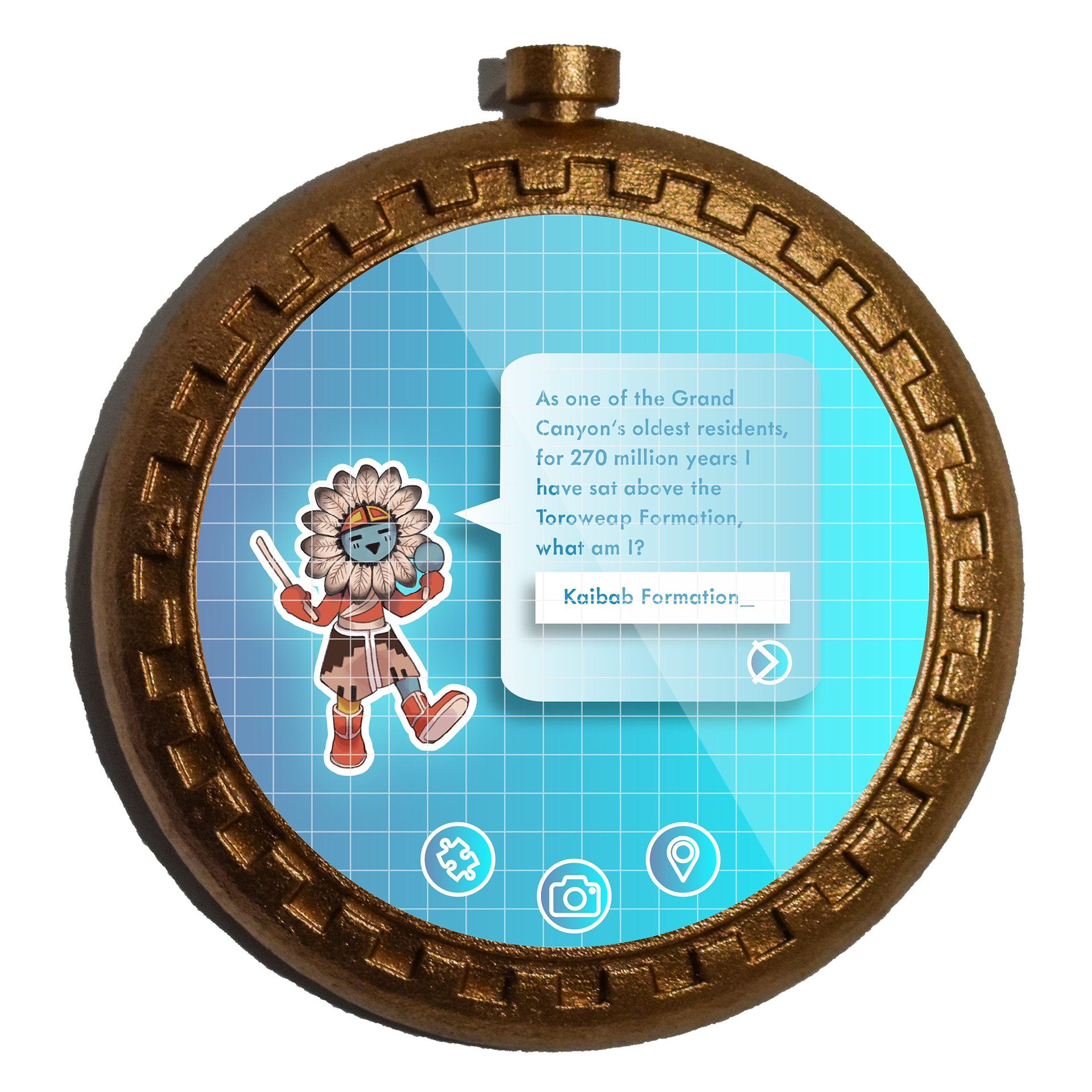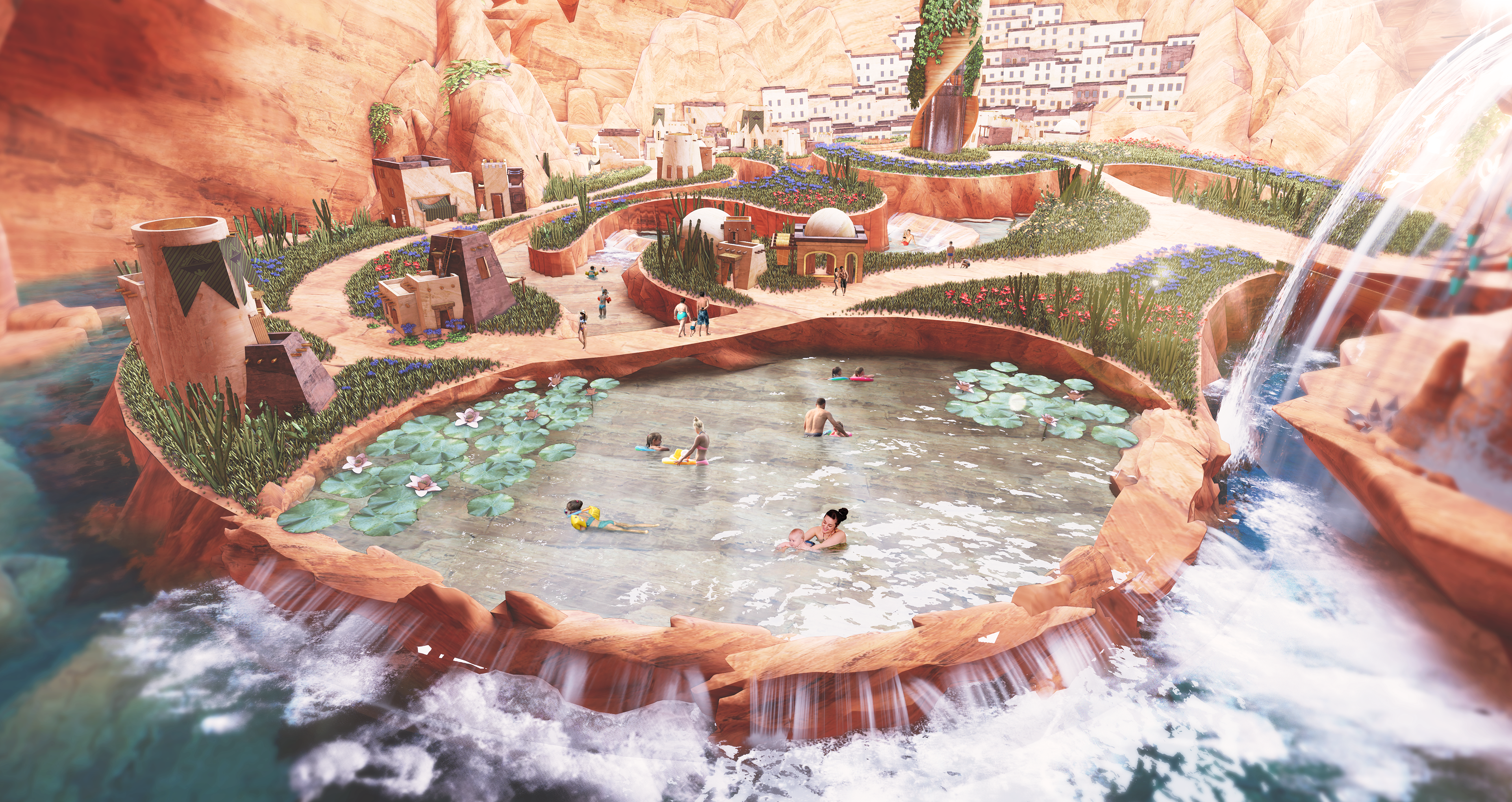
Illustration by Vanessa Astronoto
Each year, the Grand Canyon draws in millions of visitors from all over the world, the majority of whom never reach the depths of the canyon. Navigating the natural wonder poses significant obstacles, and many visitors find themselves simply peering over the rim into the landscape below. Unearth: The Grand Canyon’s Hidden Realm allows visitors of all ages and abilities to engage with one of the world’s most fascinating landscapes. Our guests embark on an immersive quest in search of a mythical civilization buried deep in the heart of the Grand Canyon. On their journey, they are able to take in the canyon’s unparalleled beauty from up close.

Illustration by Vanessa Astronoto, inspired by Michael Kabotie
There have been many stories passed down of a secret underground city in the canyon. Among these, the Native-American Hopi tribe tells the legend of “Kuzkurza,” the underground world where their ancestors, the Hisatsinom, lived in prosperity. They thrived together in harmony until a great flood, released by the god, Tawa, washed over their city. They describe a giant reed that allowed the Hisatsinom to ascend to the surface. Once they had ascended, they were never able to return to their world and instead settled on the surface.The Hisatsinom disappeared around 1250 AD, leaving very few traces of their subterranean civilization behind. However, their descendants still wait for the time when a messenger will come and guide them back to their home.

Illustration by Vanessa Astronoto
Chasing the legend, adventurers from all over the world have searched for this mysterious underground civilization. Spanish explorer Francisco Vazquez de Coronado believed the city to be El Dorado and searched fruitlessly in the area in the 16th century. The legend has persisted as late as 1909, when the Arizona Gazette published an article claiming the archaeologist G.E. Kincaid had discovered a series of secret underground tunnels left behind by an Ancient colony. Guests will join the expedition of a lifetime in search of the legendary city, picking up where their predecessors left off to find it.

Map by Hannah Williams
Our Guests will arrive at the town of Page, Arizona which is accessible from either rim of the canyon on Route 89 as well as the Page Municipal Airport. From Page, we will utilize existing city infrastructure to descend the canyon and board their Colorado river tour boat. We will travel through some of the most beautiful sections of the canyon for a two and a half hour ride before arriving at Unearth in Marble Canyon. At the end of their journey, guests may depart using Route 63A or the Marble Canyon Airport.

Boat Design by Quan Ha, Formatting by Hannah Williams

Uniform by Vanessa Astronoto

Uniform by Vanessa Astronoto

Boat Design and 3D Model by Quan Ha
All aboard the S.S. Pikeminnow! Meet your trusty captains who will guide riders on their adventure. As the journey progresses we will tell riders of the canyon lore and provide them with helpful hints to the location of Unearth. The tour boat seats twenty four visitors and departs four times a day from the dock at Page, AZ. It is engineered to be fully accessible for all passengers.

Compass Design by Hannah Williams

Compass Design by Hannah Williams

Compass Design by Hannah Williams

Compass Design by Hannah Williams
The boat captains will provide travelers with their very own personal compass. This device has been passed down through generations of explorers from the very first explorer to find the city, G.E. Kinkaid. Now, it will help guests to unlock the secrets left behind in the canyon. Utilizing bluetooth low energy beacons, the compasses will “push” a hint to travellers that there is a hidden symbol in their vicinity. Travelers will find this symbol in the canyon and then scan it using the compass’ touch screen interface. This will unlock a riddle on the compass’ LED retina display about the canyon that the travelers will work as a group to solve.

3D Terrain Model by Hannah Williams, Interface Design by Kellie Nguyen
Clues and riddles will be distributed throughout the trip and to highlight the unique landscape of the Grand Canyon. After completing each riddle, a new piece of the route to Unearth will be stored in the compass map leading guests to their destination ahead.

3D Model and Rendering by Kellie Nguyen

Graphic Layout by Hannah Williams

3D Model and Rendering by Kellie Nguyen

3D Model and Rendering by Kellie Nguyen, Graphic Layout by Hannah Williams
At last! Guests arrive at the location of Unearth at the bottom of Marble Canyon, docking at the Hidden Harbor. We will enter through the rocky overhang into a beautiful cave full of culture and adventure. We will disembark into a fully actualized land with lodging and recreational areas to enjoy. The entire destination remains underground and hidden from view in an effort to preserve the natural, uninterrupted landscape of the Grand Canyon. Unearth includes three major areas: Paayu Plaza, ECOasis, and the Prehistoric District.

3D Model and Rendering by Kellie Nguyen

3D Model and Rendering by Kellie Nguyen

Illustration by Vanessa Astronoto

Illustration by Vanessa Astronoto

Illustration by Vanessa Astronoto
Paayu Plaza contains three distinct areas: the Hidden Harbor where guests dock and arrive, Market Square where we are able to view traditional craftsmen at work and create their own crafts, and the Adobe Abodes where guests can lodge for the night. Market Square is run in partnership with the Hopi and Navajo nations which are located nearby. It engages visitors in traditional crafts within the setting of a lively market. Guests will have the opportunity to observe and learn from master artisans, preserving the culture of the Hopi tribe. An example of some traditional crafts featured in the Plaza are the Kachina dolls, who represent peaceful spirits watching over the area. Clay pottery is on display to showcase the artistry of the locals residing in Hopi Nation. Lastly, guests will experience the beauty of woven Hopi fabrics.

Illustration by Vanessa Astronoto

Illustration by Vanessa Astronoto

Uniform Fabrication by Hannah Williams
At Unearth, cast members wear uniforms that are a fictional interpretation the Hisatsinom, or Ancient Peoples, who disappeared around 1250 AD. Our costume workshop fabricated a female cast member uniform, which pays homage to the legends of the Ancient Puebloan peoples who dwelled in the Grand Canyon. They include jewelry unique to the city within Unearth.

Adobe Abodes 3D Model and Facade by Hannah Williams

Unit Floor Plan by Hannah Williams

Unit Floor Plan by Hannah Williams

Unit Section by Hannah Williams
Inspired by Ancient Puebloan cliff dwellings located in the Grand Canyon, the Adobe Abodes are built into the Canyon wall up above the rest of Unearth. These are the villagers houses, which they invite guests to visit and reside in for a time. There are two unit typologies which stack upon each other. They connect with the sloped pathways winding through the Abodes either from the front in a first story dwelling or the back in a second story dwelling. They have an accessible slope for differently-abled guests. The abodes are built from locally sourced materials. Since the material is naturally insulating when it’s cold and naturally cooling when it’s hot, air conditioning is not required.

Graphic Layout by Hannah Williams
The ECOasis is a thriving area development full of lush greenery. Trails allow guests to meander through various gardens of native flora and fauna. Towering over the city, Harmony Reed serves as the central wienie of the city. A lazy river runs through the area, where guests can get their rest and relaxation. Most of all, ECOasis showcases the riparian ecosystem. As one of the grand canyon’s diverse habitats, this ecosystem is found in areas where there is a permanent water source such as the Colorado River. While it is the rarest ecosystem in the Grand Canyon, it supports the largest biodiversity in the area. Here, guests can experience this fascinating aspect of the canyon up close. Hanging garden ferns can be seen along cave walls and climbing up Harmony Reed. The community garden is a place for locals to teach tourists about sustainable farming methods.Cactus Island is full of various desert plants. At the Canyon springs, you can find a diverse array aquatic plants such as the water lily and the wildflower fields is home to gorgeous perennials such as the scarlet monkeyflower.

3D Model and Rendering by Kellie Nguyen
The lazy river feeds into the canyon springs, a freshwater swimming hole for guests to take a dip and cool off from the Arizona sun. Using geothermal heat, the waters stay comfortable all year round.

Research and Sustainability by Quan Ha
Unearth aims to be as environmentally friendly as possible utilizing sustainability strategies. Clean water will be sourced from Roaring Springs. There will be on-site greywater treatment using the Aqua2Use GWTS 2000 system for reuse in ECOasis irrigation. The ECOasis plants will be watered using a drip-irrigation system to conserve water. Stack effect keeps the cave ventilated, but the impact on temperature is minimal. The cave temperature remains relatively constant at 63 degrees, eliminating the need to use air conditioning. Geothermal heat energy will be used for heating up water in Canyon Springs and for showers using a vertical loop system. Geothermal heat energy is great for the environment because it emits less CO2 and it is renewable energy. Electricity for lighting and the elevator is sourced from the Glen Canyon Dam, which generates hydroelectric power from the Colorado River. Similar to a past construction project in Marble Canyon, a temporary cable car system will be used to transport workers and materials to the location. To prevent cave-ins during excavation, timber shores will be used to support the rock above during construction.

Elevator Design and 3D Model by Quan Ha, Section by Hannah Williams
Harmony Reed is the connection between the third world and our own. Based on the mythology, it brings travelers up to the top of the Canyon at the end of their journey to Unearth. A machine roomless traction elevator is used to accommodate for spacing and height requirements, as well as for providing an accessible mode of transportation back to the top of the canyon for differently-abled guests. The elevator is hydro-electrically powered and will hold up to 24 people. From its glass cab, passengers command a panoramic view of the canyon around them.

Elevator Design and 3D Model by Quan Ha
As travelers rise through this elevator they will rise through 600 feet of stratified rock layers and be able to see the geologic history of the canyon before their very eyes with the assistance of interactive modules.

3D Model and Rendering by Kellie Nguyen
The Prehistoric District includes the Petroglyph Cliff, Fossil Falls Natural History Museum, and Cavernous Cuisine. Iconic staples of Arizona’s food scene are served at Cavernous Cuisine. Here, guests can enjoy a high quality dining experience with an elevated view looking out into the canyon.

3D Model and Rendering by Kellie Nguyen

3D Model and Rendering by Kellie Nguyen
Guests can find brilliant quartz crystals on display as part of the Fossil Falls Natural History Museum, a playground for curious minds to be inspired by the Grand Canyon’s vast array of geological formations.

Brochure Formatting by Hannah Williams and Kellie Nguyen
Each night, as the sun sets The “Wall of Wonder” comes to life. The half hour nighttime spectacular at Petroglyph Cliff features a light projection mapped presentation of animated cave paintings. Guests gaze up in awe as native animal species illuminate and dance along the rock wall.
This project was conceived by the University of Texas at Austin Team and created for the 2019 Walt Disney Imagineering’s Imaginations Design Competition. This project is the sole property of Walt Disney Imagineering and all rights to use these ideas are exclusive to Walt Disney Imagineering. The competition is a way for students and recent graduates to showcase their talents and for Walt Disney Imagineering to identify new talent.